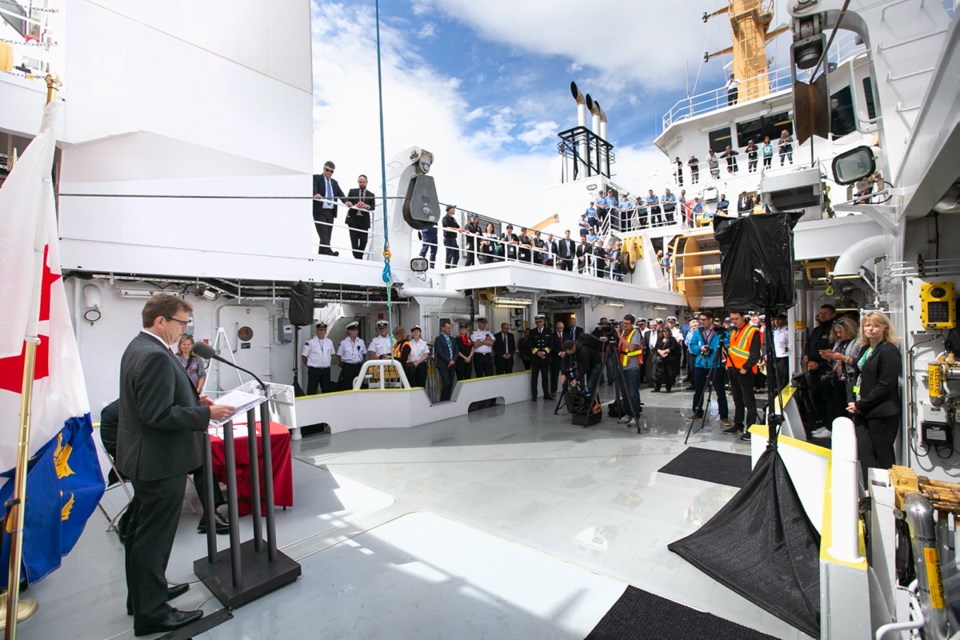You could forgive the Canadian Coast Guard for filling all the free space aboard their new vessel with crew, staff, VIPs, visitors and well-wishers Thursday to witness the handover of a ship.
After all, it’s not every day they take delivery of something new.
In fact, Thursday’s official handover ceremony for the CCGS Sir John Franklin at the Institute of Ocean Sciences marks the first time in more than 30 years that the Canadian Coast Guard has acquired a newly built ship.
“It’s a very proud day for many, and foremost it’s a proud day for the coast guard,” Andy Smith, the coast guard’s deputy commissioner, told a large crowd gathered on the decks of the Franklin.
Smith, whose smile mirrored those of the dozens of coast guard crew and staff who turned out for the event, said the sense of pride among the ranks has been something to behold, and he was clearly thrilled at the prospect of there being several more of these kinds of events in the years to come.
“This is one of those irreversible momentum stages, where we know we are now into fleet recapitalization,” he said.
Federal Fisheries Minister Jonathan Wilkinson noted the handover is a symbol of the government’s commitment to rebuild the coast guard’s capacity with investment in personnel, equipment, safety measures and adding to the fleet. “After many years of indecision, we are investing in the renewal of the coast guard fleet,” he said. “Through that we are not only strengthening the tools and technology of the Canadian Coast Guard and the marine scientists that work alongside the coast guard, we are revitalizing the Canadian shipbuilding industry.”
The 64-metre Sir John Franklin is the first large vessel designed and built under the federal government’s national shipbuilding strategy. It is the first of three offshore fisheries science vessels being constructed by Seaspan.
In May, Prime Minister Justin Trudeau announced Seaspan would build another 16 multi-purpose vessels, like the Franklin, as part of a $15.7-billion shipbuilding plan that includes two Arctic patrol vessels to be built in Halifax.
Seaspan chief executive Mark Lamarre, said despite 35 years in the business — he has been part of building 47 vessels — the handover ceremony never gets old.
“I’ve been doing this a long time and it feels like this, every time,” he said of the milestone.
He echoed Wilkinson, noting it’s not just about a new ship for the coast guard, but it also marks a milestone for the re-establishment of the shipbuilding industry in B.C. “When you build ships, you build more than ships,” he said. “We are building an industry and building world-class capability for design, construction and sustainment on the West Coast of Canada.”
While he wouldn’t say the coast guard has been neglected, Smith clearly believes this kind of investment has been overdue.
“I would tell you the average age of our large ships is 38 years old. It’s a well-maintained fleet, reliable and safe, but it is time to recapitalize the fleet,” Smith said, calling Trudeau’s announcement “generational” in its importance.
“If you look at the capability of this ship compared to the old ship [it replaces the CCGS W.E. Ricker], which was a venerable old girl who served us well, it’s a quantum leap in terms of capability, science and navigation. It’s a totally different ball game.”
The vessel, is considered a major upgrade from the Ricker with improved amenities for the crew and was a complex build as it was designed specifically to meet the needs of the coast guard and scientists from the Department of Fisheries and Oceans.
The vessel includes high-tech fishing trawls, laboratories and a deployable drop keel. It will serve as a platform for DFO to monitor the health of fish stocks and better understand the impacts of climate change.
Carmel Lowe, regional science director for the DFO, said their team is extremely excited to get to work on the new vessel. She said the Franklin features state-of-the-art technology and the ability to conduct round-the-clock operations as it supports fishery stock assessment and monitoring work to manage species-at-risk, supporting healthy fisheries and monitoring the effectiveness of new marine protected zones.
Lowe also paid tribute to the Ricker, noting its integral role in better understanding marine resources off B.C.’s coast over 31 years as it conducted more than 200 scientific missions totalling 3,500 days at sea.
Smith said there are great expectations for the new vessel as a support ship in the coast guard fleet and as a scientific platform. He said over the next four to six months the crew will get familiar with its systems at sea. He expects the first scientific voyage to be conducted in six months.
The Ricker will be scrapped.



